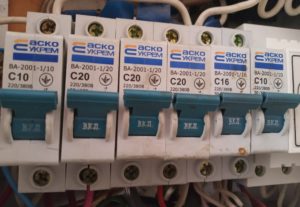
I think this article will be useful not only to people who are far from electricity, but who consider themselves experts in all fields, but also to seasoned electricians with 30 years of experience.
But first, the backstory...
It was about… 15 years ago.
I was just starting to try my hand at electrical wiring. Often already worked independently. Without experienced colleagues...
Of course, he also performed wiring repairs at home on his own. So…
We built a garage with my father. I did the wiring myself. The materials used were good. For yourself! Three-core copper cable 2.5 squares: VVG 3x2.5. Everything is in the cable channel, Vikosh sockets ... I even made grounding.
But I just didn’t have enough cable to power this entire architecture. Either the money ran out, or he was in a hurry. I don't remember anymore. In short, I powered the garage with used “noodles” (copper wire in one insulation - PPV2x2.5). Temporarily of course.
A year has passed. And as the popular saying goes: "There is nothing more permanent than temporary." So the noodles remained on the garage. Frost, precipitation and the sun did their job: the insulation in many places burst. But I did not betray this - the wire is suspended at a height of more than 2 meters, the cores do not touch each other, no one climbs there with their hands.
So what can happen to him? And that's what happened...
One evening, I return home. The weather was nasty: there was thick fog. I go up to my house and through the fog I see that someone is doing welding work in my yard. I think: “Dad, did he decide to cook something for the night?”
But when I entered the courtyard, I saw the following picture: the cable (i.e. noodles), which powered the garage, was cut off from the side of the garage and it was burning like a "sparkler". The arc gradually moved along the "noodles", getting closer to the house.
Fearing to fall under the "stepping voltage", I rode past this fireworks on one leg, ran into the house and turned off the machine. I cut off the emergency wire and turned on the electricity again.
I figured out what happened the next day. A huge mystery for me was the question - “Why didn’t the machine work ??? After all, it was brand new, and it was designed for a relatively small load - 20 Amperes "
“Grandfathers” from work helped to understand the situation. The first thing they asked was: “Did you measure the phase-zero loop?”
-What loop? What are you shipping me? was my answer.
The guys tried to explain to me what it is and how it is “eaten”. To be honest, I didn't understand anything. Then they explained to me in a more understandable language. I want to tell you about this too. In simple (as far as possible) words:
Circuit breakers protect our wiring with two types of protection.
With the help of a thermal release (long-term overloads exceeding the rated current by several tens of percent. For example, an automatic machine marked C16 will work in a few tens of seconds when a current of ... 20 Amperes flows through it)
And an electromagnetic release, which should work almost instantly in case of a short circuit (for example, at a current of 300A).
So. Most masters choose machines, taking into account only the rated current. That is, they provide for an emergency shutdown when the load is exceeded above that which is written on the machine (C16 - 16 Amperes, C25 - 25 Amperes, etc.) The response time of the "heat blower" is from several tens of seconds to several minutes. It all depends on the amount of current.
But about the electromagnetic release ... either they don’t know, or they forget. And its parameters are indicated by the very letter that comes before the numbers!
Let me tell you with an example. So it will be clearer.
We take a machine marked C16. The letter "C" means that the electromagnetic release will operate at 5-10 times the rated current for a fraction of a second. That is, at a current of 80-160A. Moreover, the higher the current, the faster it will work.
And in the machine marked B16, the electromagnetic release will work at 3-5 times the rated current. That is 48-80A.
All this mathematics is clearly visible in these graphs:
And now the most important thing!!!
If the short-circuit current in the outgoing network is LESS than the operating current of the high-speed electromagnetic release, then ... it most likely will not work. And the thermal release will work, but the time of its reaction to what is happening is much longer.
At work, "on my word of honor", I took a device to measure the resistance of the "phase-zero" loop and the short-circuit current. I will not load you with the first parameter, I will tell you what happened when measuring the short-circuit current.
About this device, I already made a small reviewer 4 years ago.
Don't take it as an advertisement, but if you are serious about electrical installation ... such a device (or similar) will be useful to have. And if you also work officially ... it will help you earn an extra penny.
Here is a link to the video: Measurement of short circuit current ....
But a very sad picture turned out: on the introductory machine (C20) - short-circuit current. amounted to only 130A. When I went to measure around the house - in the sockets it generally fell to 80-90A (group machines - C16)!
What's the deal here...?!
To increase the short circuit current, I had to replace the old aluminum air tube with a bunch of twists with SIP. On the introductory machine, short-circuit current increased to 300A !!!!
I immediately tested a new circuit: I shorted two wires “insolently”. And you know... knocked out!